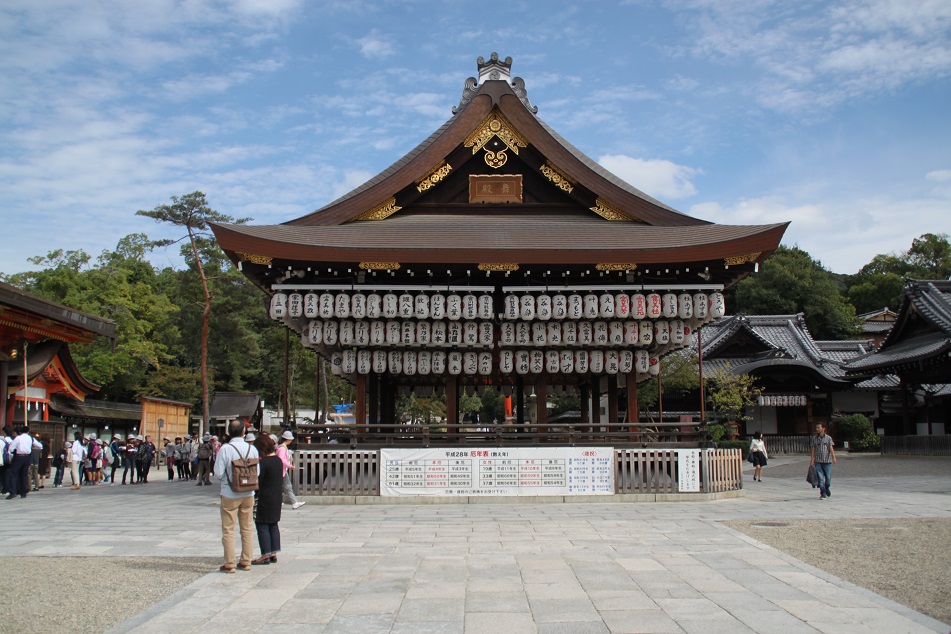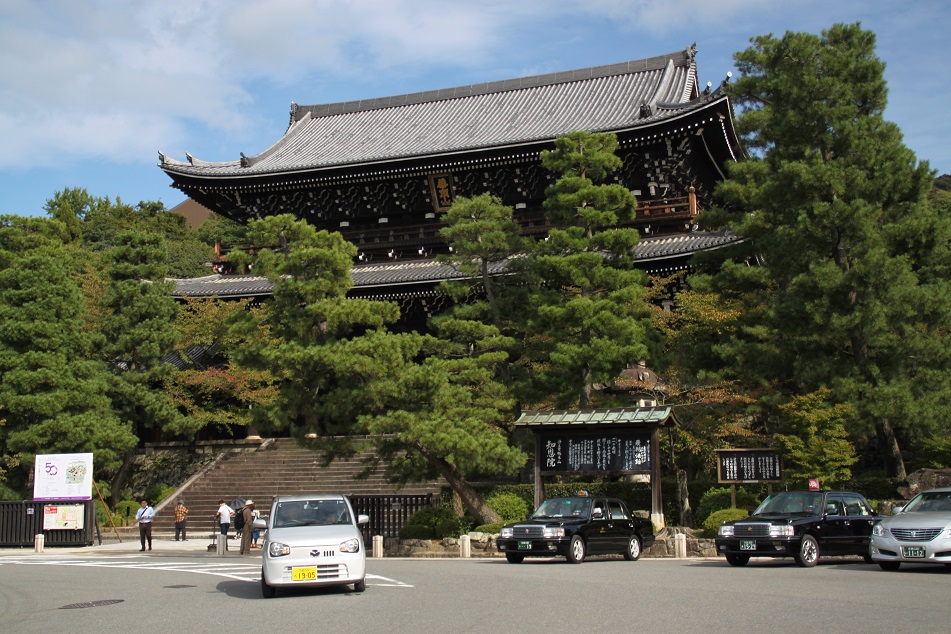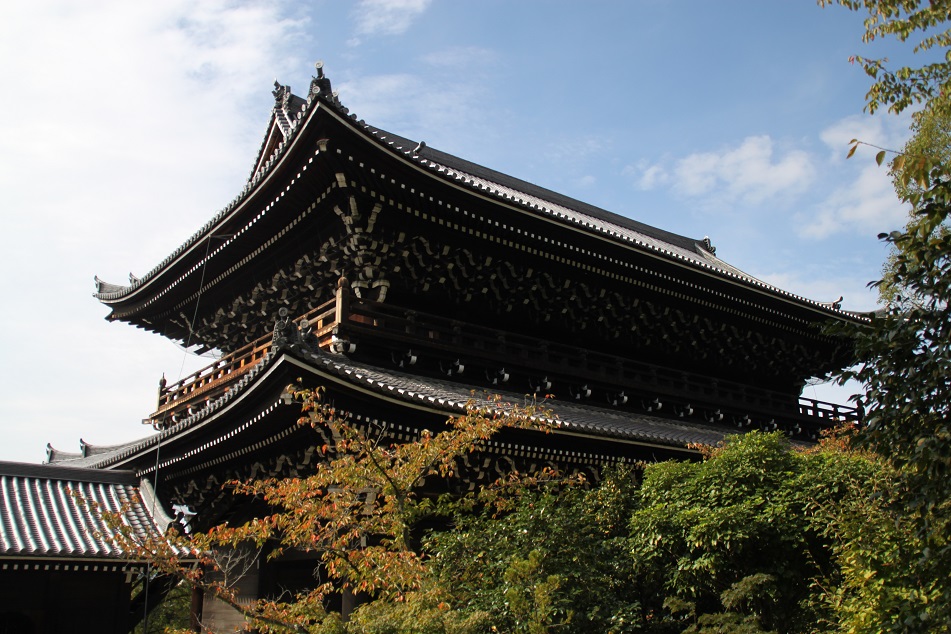In the former imperial capital of the Land of the Rising Sun, the native Japanese religion of Shinto as well as Buddhism, which found its way from India to the Far East, occupies a special position not only in the local community, but also in the country. While kami are worshiped in the Shinto universe, like Inari, the kami of rice, sake, agriculture and industry whose messengers – the foxes – are ubiquitous at Fushimi Inari-taisha, the multiple branches of Japanese Buddhism emphasize the worship of deities.
At the heart of Kyoto, Yasaka Shrine is a Shinto compound dedicated to Amatsukami and Kunitsukami, the kami residing in the heaven and on the land of Japan, respectively. With its history dating back to the seventh century, the shrine’s prominence grew in the centuries that followed which eventually led to its designation as one of the Kanpei-taisha, the most highly ranked imperial shrines of Japan, in the 19th century. Due to its significance, throughout its history Yasaka Shrine witnessed more and more accommodation being built nearby to cater for pilgrims and visitors to the shrine. However, today this district, Gion, is better known for its geisha, skilled female artists recognizable from their elaborate makeup and costume.
Chion-in, on the other hand, is a temple of Jodo Buddhism, one of the main schools of the religion in Japan which was established by a spiritual leader called Honen in the 12th century. Honen himself was a reformer, Japanese Buddhism’s own version of Martin Luther, who founded Jodo (Pure Land) Buddhism independent from Tendai, a school of Mahayana Buddhism popular in Japan at that time. His teaching focuses on the veneration of Amida (Amitabha), a celestial Buddha attributed for his comprehensive love and blessing for all beings. The main temple dedicated to Amida was constructed in the 13th century, a few decades after Honen’s death. However, the most impressive part of the temple compound is arguably the Sanmon, a 17th-century colossal wooden gate that soars 24 meters high on the slope of a verdant hill.
Both the houses of the kami and Amida are now among the treasures from Japan’s past that managed to avoid the destruction wrought by bombs and modern weapons which have annihilated invaluable monuments all over the world, from churches in Europe to ancient Hindu temples in Vietnam. Some of those have been rebuilt to their original appearance, but one can imagine how much more fascinating the world would have looked had those masterpieces from the past survived. Yasaka Shrine and Chion-in are a testament to what peace can bring to humanity, when compassion is nurtured and hatred is buried. May the two temples stand for many more generations to come.













Beautiful photos! I like the one with the man reading the verses written with these beautiful Japanese characters. Thanks for the visual tour through the former capital of Japan, Bama!
LikeLiked by 1 person
I was lucky to see that man just at the right time. I can’t read those words, but the way he looked at them was sort of contemplative. I still have two more posts from Kyoto, so please bear with me. 🙂 Thanks for reading, Peter!
LikeLiked by 2 people
I was just going to type the same thing that Peter did, above! Such a simple, perfect photo. (Lots of other good ones, too.)
LikeLiked by 1 person
Thanks Lex! The timing couldn’t have been more perfect — had I looked at something else I wouldn’t have spotted this man. However there were times when I wished I had my camera ready when I saw interesting things before my eyes.
LikeLiked by 2 people
Our trips to Japan have been amazing. We love the culture and architecture. Thanks for your great pictures. Nancy at Boyer Writes
LikeLike
Isn’t Japan a very special place? I don’t know anyone who has traveled to the country but ended up not liking it. I definitely can see myself returning one day!
LikeLike
Another great post!
LikeLike
Thanks John & Susan! I’d better publish the rest of my posts on Japan soon as I just returned from two separate trips last week.
LikeLike
Mas Bama,
Duh baca ini jadi merasa bersalah ngga mampir deh, karena kaki sudah gak bisa diajak kompromi lagi hahaha. Kapan yaa harus kesana lagi…
Tapi lucunya, aku sempet ke Yasaka Pagoda yang rupanya gak sekompleks dengan Yasaka Shrine ya, dan menemukan perempuan-perempuan bermuka cat putih yang berpakaian tradisional Jepang yang entah fake atau beneran hahaha…
LikeLike
Rasa bersalah itu hanya bisa terbayarkan dengan cara datang lagi ke sana mbak. #ngomporin 🙂
Nah saya juga sebenernya penasaran gimana caranya bedain yang beneran geisha dan mana yang cuma dandan buat difoto sama turis.
LikeLike
Katanya sih kalo jalannya ngebut, tergesa-gesa dan gak mau difoto itilah yang asli karena mereka selalu harus ontime dengan tamunya. Katanya lagi, bisa dibedain dengan warna kerahnya antara maiko asli dan geisha asli dan yang palsu.
LikeLike
Betul itu yang saya baca. Tapi karena mereka jalannya cepat jadinya pas mau merhatiin kerahnya juga susah. 😀
LikeLike
Bama, amazing pictures, I love the architecture of the temples in Japan. This place reminds me of the movie “Memoirs of a Geisha” I would love to visit these places one day! Thank you for sharing your trip with us.
LikeLike
Thank you, Liz! Japanese temples really are beautiful, not only because of their colors and curves, but also the wood material that is essential in their construction. Despite its popularity, actually I haven’t watched Memoirs of a Geisha which seems to have shaped many people’s perception of Kyoto. As someone who loves cultures, I think you’d find Japan a very fascinating place.
LikeLiked by 1 person
I really love the photo of the man reading the verses. Some super neat stuff about Japanese religion. Thank you for the insight and educational experience.
Jess
LikeLike
Thanks Jess! Glad you enjoyed a little bit of history of both places. I wish I had more time in Kyoto to experience both sanctuaries at night.
LikeLiked by 2 people
Fascinating images – inspiring!
LikeLike
Much appreciated! Thanks for reading.
LikeLike
These two religious sites were new for me too, Bama, as they were not on the itinerary the last time I was in Kyoto all those years before. I enjoyed Yasaka Shrine but what took my breath away was the sheer scale and height of Sanmon at Chion-in. And to think that it was built almost entirely out of wood! Surprisingly I was not so bummed that the main hall was under renovation, but then again I recall reading about Sanmon and seeing an ethereal photo of it in the rain when I was still at school… that certainly left a very deep impression on me.
LikeLike
Actually I wasn’t too disappointed either to see the main hall of Chion-in completely covered due to the renovation work. That impressive Sanmon really was the highlight of our visit to the temple ground, and what is mind-blowing is the fact that it has withstood centuries of Mother Nature’s brute force as well as wars among men.
LikeLiked by 1 person
Bama beautiful photos as always. The way you creatively capture the shrines with different angles and perspectives inspires me to do better. In Tokyo i felt challenged trying to get the full essence of the places we saw.
LikeLiked by 1 person
Thanks Sue! I’ve never been to Tokyo, but I can imagine the challenge you faced for it is such a big metropolis.
LikeLiked by 1 person
Pingback: Kyoto Sanctuaries: Yasaka Shrine and Chion-in — What an Amazing World! – ROSEMARY NGUYEN
Thank you for posting this article. I have been living in Yokosuka for al little over 2 years and I have yet to visit Kyoto. Before I leave I would love to travel there. This article is packed with so much I’m sure I’ll have to read through once again and often! This was great!
LikeLike
Yokosuka (and Greater Tokyo) is among parts of Japan I most want to visit the next time I go to the country. You definitely should go and see Kyoto for yourself while living in Japan; it’s one of the most fascinating cities I’ve ever been in my life. Thanks for dropping by!
LikeLiked by 1 person
No problem at all, the pleasure is all mine and I have every intention to visit Kyoto before I depart from this beautiful country. Thank you for responding!
LikeLike
The pleasure is mine.
LikeLike
Your photos really show off the incredible grace of this type of architecture. I love the way the curved roofs flip up at the corners! And while being quite ornate, they are not gaudy. Excellent!
LikeLike
You sum up Japanese aesthetics quite well. The Japanese are known for their penchant for simplicity. However, there are examples of richly-decorated palaces or temples. But even so, they always manage to look elegant. Much appreciated, Marilyn!
LikeLike
I just came back from Kyoto and visited this place. It was peak tourist season and the scenes there are such a marked contrast from your photos. It was more like a mad house while I was there.
LikeLike
Oh my, sounds like it was not an ideal time to visit Kyoto. When I went in autumn it was quite nice; there were quite a lot of tourists around but I didn’t feel overwhelmed at all.
LikeLiked by 1 person
That Sanmon is truly impressive. Love your closing shot. Our time in Kyoto was too short to include these shrines. Hope to return in time for sakura someday. Perhaps clubbed with Seoul 🙂
LikeLike
Yes! A few days in Seoul (more if you want to visit some really old temples and tombs in Gyeongju) would be nice to kick off your next trip to East Asia. I recommend going in last week of March/first week of April, although with climate change things become less and less certain these days.
LikeLike